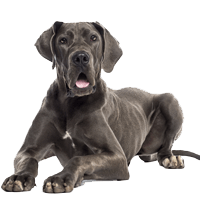
Suggested tests: Cardiac, elbow, hip, eye, blood
Life span: 6 – 8 years
Avg Size of Male: Height: 30 – 32 inches, Weight: 100 – 120 pounds
Avg Size of Female: Height: 28 – 30 inches, Weight: 100 – 120 pounds
Occasionally seen: Glaucoma, VWD
Minor concerns: CVI (wobbler’s syndrome), cataract, elbow dysplasia, osteosarcoma, OCD, HOD
Major concerns: Gastric torsion, CHD, cardiomyopathy
Great Dane Breed History
Because of its agility, strength and ability to cover lots of ground, the Great Dane became very popular as skillful hunters of wild boar in Germany. The Great Dane also became popular with nobility, due to its commanding but regal appearance. The English began calling the breed German Boarhounds, but at some point for unknown reasons, it began to be referred to as the Great Dane. Some confusion began to arise because this dog wasn’t Danish. In approximately 1880, German authorities proclaimed that the Great Dane should only be referred to as the “Deutsche Dogge”, and this is the name still used in Germany to this day. This breed came to the United States in the late 1800s, and it quickly gained recognition because of its unique and large stature. To date, this massive dog is still a popular breed in America. Its talents include tracking, carting, and serving as a watchdog.
Great Dane Breed Appearance
The Great Dane is one of the tallest breeds. It has a square and very well-proportioned appearance. The front set of legs are muscular and straight, while the hindquarters are broad and powerful. The feet are large and compact. The tail is medium in length, set high and is broad at the base, tapering down consistently to the end. The neck is arched and muscular, and blends smoothly into the strong back. Sculpted and chiseled in appearance, the head is elongated and features a broad muzzle and a square-shaped jaw. The eyes of the Great Dane are medium size and usually dark in color, with an sophisticated and calm expression. The ears are medium in size, and fold over toward the cheek. The ears are commonly cropped for the appearance in the U.S, but this practice is not common in Europe and even prohibited in some areas in the states. Some theories suggest that cropping the ears was common back in the day when they were used for hog hunting so that the hogs would be unable to bite and pull at their floppy, dangling ears. The nose of the Great Dane is usually dark in color or black, with a large nasal canal. The teeth meet in a scissor bite. The gait is best described as powerful, featuring long, smooth strides. The coat is best described as firm and short with a glossy sheen. The six colors variations that are acceptable at a show are: black, blue, fawn, mantle, harlequin, and brindle.
Great Dane Breed Temperament
The Great Dane is a loyal, gentle and friendly breed despite its gigantic size. This type of dog is normally very good with children, although younger children can easily be overpowered by the large dog’s affection and play. Though the Great Dane is strong, sensitive, and intelligent and quite responsive to firm and positive training. Supervision is recommended around smaller dogs and pets, this breed is generally friendly with other animals but it’s size and weight can cause accidents. Obedience training is recommended from an early age, to ensure that this dog will be more manageable and well-behaved when it’s fully grown. Sometimes the Great Dane may display aggressive or domineering behaviors towards other dogs of the same sex. This breed should be kept indoors – keeping in mind that it requires space to be able to stretch out its long legs and large body. If you live in an apartment, and it is not spacious, this is not the breed for you. It also should not be kenneled.
Great Dane Breed Maintenance
Since the Dane has such a short, close coat, only minimal grooming is necessary. Just brush or comb, and use dry shampoo when you feel it is needed. Bathing this dog is truly a huge chore because of its size. Maybe consider a kiddie pool, a hose and some doggy shampoo for that task. This breed is an average shedder. You should trim their nails regularly to prevent them from growing uncomfortably long. Daily exercise is necessary for this breed, whether it is a daily walk to the park or some vigorous play time in the yard. It should spend plenty of time outdoors where it has plenty of space to run and play, as it is generally inactive while indoors. It may get cold in the winter and should not be left outside for long periods of time. A home with a medium or large fenced-in yard would definitely be ideal. Your fence should be at least six feet tall to prevent the dog from easily jumping over it and escaping. While indoors, this dog should have soft bedding to lay on with plenty of room to stretch and rest. As with many other large breeds, the Great Dane has a shorter lifespan than most smaller dogs. Generally having a life span of six to eight years. They also have some common health issues that are associated with most larger breeds, such as bloat and hip dysplasia.
 Toledo, United States.
Toledo, United States.